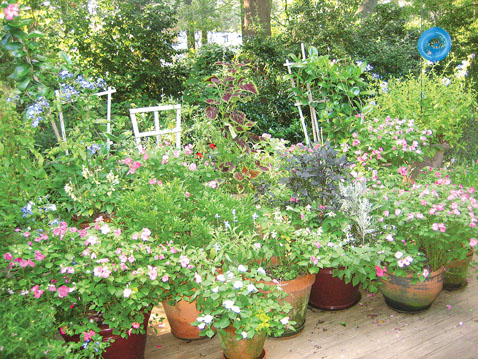Deer-Terrents
29 Jan 2011

- These cute but pesky garden visitors can attract predators like mountain lions into your yard. Photo by Ty Wyant

- Experts promote planting native deer-proof plants like these little beauties (below), which also thrive on minimal water. Top to bottom: Golden Banner, Cutleaf Fleabane, Bell's Twinpod. Photo by Dave Sutherland
Water Spooks
Deer love to drink from water features and fountains, but sprinklers can spook them. Sandy and Bill Ingalls added a motion-activated sprinkler to their Boulder garden two years ago after deer began snapping their apple saplings in half. They affixed sprinklers at opposite ends of the 20-by-30-foot garden, and lifted bird feeders out of the animals’ reach with pulleys. “I haven’t seen any deer in the yard since we did that, so it seems to be working,” Sandy says. In plotting deer defenses, be careful about planting nonnatives that could grow into more of a nuisance than the deer. Myrtle spurge, for example, is a drought-tolerant perennial that’s invaded natural areas around Boulder and Fort Collins. While unpalatable to deer, it causes other ecological problems. “Nonnative species can find a niche in our ecosystem and disrupt the way the ecosystem functions, either by suppressing or competing with native vegetation,” says Adrian Card, who manages the Wildlife Masters program at Colorado State University Extension. Myrtle spurge was sold at local garden centers until “we realized it’s not the best choice, and now we’re trying to reel it back in,” he says. “There is lots of it in Boulder.” Lieberman’s neighbor planted two or three nonnative goat shrew plants she purchased from a local store years ago to keep deer away. By the following spring, however, the pretty purple flowers had encroached down the hill toward Lieberman’s house. “We had no idea it was such a menace. Its roots are deeper than yucca, and it trellises over other plants and steals sunshine and water,” Lieberman says. “I can’t tell you the number of hours we’ve spent trying to get rid of it.” While different deer-proof strategies suit different homes, no method is foolproof. “They have preferences,” Card says of deer. “However, a deer that’s hungry enough will eat pretty much anything.”Online Resources
 Boulder County’s website includes a full list of pretty native plants that discourage deer.
The Colorado State University Extension website provides tips for dealing with urban wildlife.
Boulder County’s website includes a full list of pretty native plants that discourage deer.
The Colorado State University Extension website provides tips for dealing with urban wildlife. 














